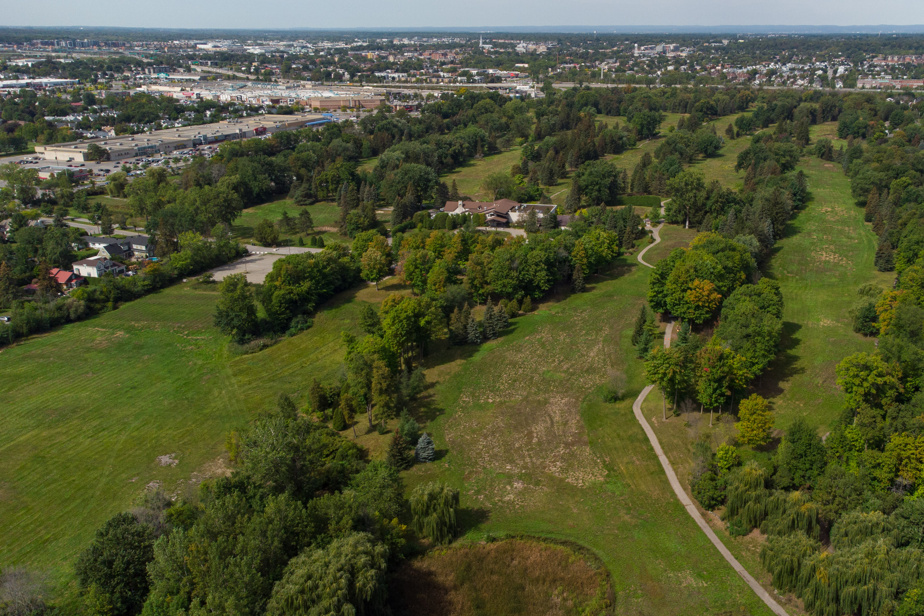Four former golf courses, whose owners are suing the Montreal Metropolitan Community (CMM) for more than $500 million because they were prohibited from developing their land, can now be converted into residential or other projects on 30% of their surface area, following a change to the regulations announced Tuesday.
What was announced?
The CMM modified an interim control regulation (ICR) which imposed, since 2022, a freeze on development on nine golf courses, closed or active. This RCI was intended to help the CMM achieve its objective of protecting 30% of green spaces on its territory by 2030.
What does it change ?
Now, ten golf courses are on the list of protected spaces, but five of them will be able to develop 30% of their territory, if the municipality authorizes it. In fact, cities can still decide to protect 100% of their golf courses.
The protected areas on these ten golf courses total 460 hectares, while the area protected by the old version of the RCI totaled 474 hectares.
“For the 30% of surface area [non visée par le RCI]it could be protected or purchased by the municipality, it can be used for other specific needs such as housing, a school or other, or remain a green space,” underlined the mayor of Montreal and president of the CMM, Valérie Plante, at a press conference.
Land 70% protected
- Rosemère Golf Course (closed)
- Candiac Golf Club (closed)
- Mascouche Golf Club (closed)
- Golf Le Boisé, in Terrebonne (closed)
- Golf Ste-Rose, in Laval
Land 100% protected
- Beloeil Golf Club
- Boucherville Golf Club
- Golf Dorval
- St-Lambert Golf Club
- Country Club of Montreal, in Saint-Lambert
Why this change?
The owners of four of the five golf courses which will now be able to develop at 30% are suing the CMM for disguised expropriation, because the old RCI prevented them from carrying out their real estate projects.
In Rosemère, Quartier Melrose inc. filed a 278 million lawsuit against the City and the CMM. In Candiac, the company 9454-9607 Québec inc., chaired by Minying Wu, is demanding 69.2 million from the municipality and the CMM. On the Mascouche side, the company 9254-0087 Québec inc., which belongs to businessman Claude Duchesne, is asking for 62.5 million. In Terrebonne, the developer Immeubles des Moulins, owner of the Le Boisé golf course, filed a lawsuit for 98 million.
These legal procedures put obstacles in the way of municipalities that would like to purchase certain land, underlines Valérie Plante. “This is not possible if local governments are saddled with lawsuits and procedures that are very expensive, time consuming and can cause delays in transactions,” she says.
Will changes to the RCI put an end to prosecutions?
It is not certain. We contacted the lawyers representing the developers who filed these lawsuits, and three of them responded that they could not comment because further analysis of the changes was necessary.
How was the 30% proportion chosen which will no longer be protected?
It is based on a decision rendered last October by a judge of the Superior Court, in a dispute between the City of Léry and owners of land located in the Châteauguay-Léry green corridor. In this location, the zoning regulations allow owners to develop 30% of their land, while the rest must remain green space.
The judgment ruled in favor of the City and the MRC du Roussillon, ruling that the owners were not victims of disguised expropriation because the 30% limit was “reasonable”. It was, however, appealed by the owners; the case will be heard in February by the Court of Appeal.
Why has the list of protected golf courses changed?
Two Saint-Lambert golf courses have been added. However, the former Chambly golf course was removed from the list since the City entered into a tripartite agreement to purchase 70% of the land, for 6 million, in order to turn it into a park. The rest of the space will become a new residential area where 500 homes will be built.
How do environmentalists react?
The spokesperson for the Coalition of Golf Courses in Transition (CTGT), Catherine Vallée, says she is disappointed to see that the CMM has backed away from “suits by owners for exorbitant amounts, which are insecure and intimidating”.
According to her, the recent changes made to the Law on development and town planning make it possible to protect these green spaces in their entirety, when they are wet or watery environments or an environment that has significant ecological value.
With Éric-Pierre Champagne, The Press
